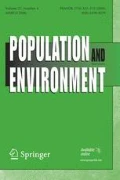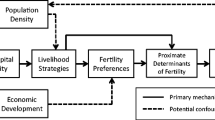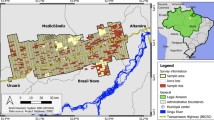Abstract
Demographic interest in population and environment has grown in recent decades. One of the most prominent research areas in this tradition addresses the impact of population on land use and land cover change. Building on this tradition, we examine the effects of household demographic composition on land use and land cover on small farms in two study areas in the Brazilian Amazon. Fixed effects regression models of used area and forested area show few consistent effects of changes in household demography on land use and land cover change. Effects are inconsistent with the household life cycle model that currently dominates the literature on household demographic effects in frontiers. Changes in the number of children and women, particularly young women, have the most significant effects on land use and land cover change. We conclude by arguing that households strategically access cash for investment in agriculture and that specific strategies are determined by economic and institutional context.



Similar content being viewed by others
Notes
Sampled properties were not replaced with alternates because of owners refusing to participate. In this wave of data collection we had no farmers refuse to participate in our study.
SS3 is the most advanced secondary growth, while SS1 is the least. In 1991, the classification also included a category for sugar cane, capturing a short-lived explosion of sugar cane cultivation during the operation of a factory for converting sugar cane to alcohol. These areas were subsequently abandoned or converted to other uses, primarily cocoa. We do not use this category in our analyses.
The differences among the classifications reflect both differences in the ability of the research team to distinguish categories and differences in the initial uses of the classified imagery.
For ease of analysis, we use the xtreg, fe command in Stata. We replicated the results using two other methods: using OLS regressions with dummy variables for all households and using OLS regressions of deviations in a given dependent variable from the household mean on deviations in the independent variables from their household means. These methods all produced the same coefficient estimates for the effects of household composition, though the OLS using deviations method produced smaller standard errors because it did not account for the degrees of freedom lost because of the household fixed effects.
In these models and models of other dependent variables, we tested for collinearity and found no problems. The maximum variance inflation factor for any variable in any of the models was 2.94 in Santarém and 1.96 in Altamira.
References
Barbieri, A. F., Bilsborrow, R. E., & Pan, W. K. (2005). Farm household lifecycles and land use in the Ecuadorian Amazon. Population and Environment, 27(1), 1–27.
Barbieri, A. F., & Carr, D. L. (2005). Gender-specific out-migration, deforestation and urbanization in the Ecuadorian Amazon. Global and Planetary Change, 47(2–4), 99–110.
Bongaarts, J. (1992). Population growth and global warming. Population and Development Review, 18(2), 299–319.
Boserup, E. (1981). Population and technological change: A study of long-term trends. Chicago: University of Chicago Press.
Brondízio, E. S., McCracken, S. D., Moran, E. F., Siqueira, A. D., Nelson, D. R., & Rodriguez-Pedraza, C. (2002). The colonist footprint: Toward a conceptual framework of land use and deforestation trajectories among small farmers in the Amazonian frontier. In C. H. Wood & R. Porro (Eds.), Deforestation and land use in the Amazon (pp. 133–161). Gainsville, FL: University Press of Florida.
Carr, D. L. (2004). Proximate population factors and deforestation in tropical agricultural frontiers. Population and Environment, 25(6), 585–612, 528.
Chayanov, A.V. (1966). The theory of peasant economy. Homewood, IL: Richard D. Irwin.
Dietz, T., & Rosa, E. A. (1997). Effects of population and affluence on CO2 emissions. Proceedings of the National Academy of Sciences of the United States 94(1), 175–179.
Ehrhardt-Martinez, K., Crenshaw, E. M., & Jenkins, J. C. (2002). Deforestation and the environmental Kuznets curve: A cross-national investigation of intervening mechanisms. Social Science Quarterly, 83(1), 226–243.
Ehrlich, P. R., & Holdren, J. P. (1971). Impact of population growth. Science, 171, 1212–1217.
Entwisle, B., & Stern, P. C. (Eds.) (2005). Population, land use and environment: Research directions. Washington, DC: National Academies Press.
Evans, T. P., VanWey, L. K., & Moran, E. F. (2005). Human-environment research, spatially explicit data analysis, and GIS. In E. F. Moran & E. Ostrom (Eds.), Seeing the forest and the trees: Human-environment interactions in forest ecosystems (pp. 161–185). Cambridge, MA: MIT Press.
Futemma, C., & Brondízio, E. S. (2003). Land reform and land-use changes in the lower Amazon: Implications for agricultural intensification. Human Ecology, 31(3), 369–402.
Goody, J. (1958). The developmental cycle in domestic groups. Cambridge, England: Published for the Department of Archaeology and Anthropology at the University Press.
Judge, G. G., Griffiths, W. E., Hill, R. C., Lütkepohl, H., & Lee, T.-C. (1985). The theory and practice of econometrics. New York: John Wiley and Sons.
Lambin, E. F., Turner, B. L., Geist, H. J., Agbola, S. B., Angelsen, A., Bruce, J. W., Coomes, O. T., Dirzo, R., Fischer, G., Folke, C., George, P. S., Homewood, K., Imbernon, J., Leemans, R., Li, X. B., Moran, E. F., Mortimore, M., Ramakrishnan, P. S., Richards, J. F., Skanes, H., Steffen, W., Stone, G. D., Svedin, U., Veldkamp, T. A., Vogel, C., & Xu, J. C. (2001). The causes of land-use and land-cover change: moving beyond the myths. Global Environmental Change-Human and Policy Dimensions, 11(4), 261–269.
Malthus, T. R. (1989) [1803]. An essay on the principle of population. Cambridge: Cambridge University Press.
Marquette, C. M. (1998). Land use patterns among small farmer settlers in the northeastern Ecuadorian Amazon. Human Ecology: An Interdisciplinary Journal, 26(4), 573–598.
McCracken, S., Siqueira, A., Moran, E. F., & Brondízio, E. S. (2002). Land use patterns on an agricultural frontier in Brazil; Insights and examples from a demographic perspective. In C. H.Wood & R. Porro (Eds.), Deforestation and land use in the Amazon (pp. 162–192). Gainsville, FL: University Press of Florida.
McCracken, S. D., Brondizio, E. S., Nelson, D., Moran, E. F., Siqueira, A. D., & Rodriguez-Pedraza, C. (1999). Remote sensing and GIS at farm property level: Demography and deforestation in the Brazillian Amazon. Photogrammetric Engineering & Remote Sensing, 65(11), 1311–1320.
Moran, E. F. (1981). Developing the Amazon. Bloomington, IN: Indiana University Press.
Moran, E. F., Brondízio, E. S., & McCracken, S. (2002). Trajectories of land use: Soils, succession, and crop choice. In C.H. Wood & R. Porro (Eds.), Land use and deforestation in the Amazon (pp. 193–217). Gainsville, FL: University of Florida Press.
Moran, E. F., Brondízio E. S., & VanWey L. K. (2005). Population and environment in Amazônia: Landscape and household dynamics. In B. Entwisle & P. C. Stern (Eds.), Population, land use and the environment. Washington, DC: National Academies Press.
Murphy, L. L. (2001). Colonist farm income, off-farm work, cattle, and differentiation in Ecuador’s northern Amazon. Human Organization, 60(1), 67–79.
O’Neill, B. C., MacKellar, F. L., & Lutz, W. (2001). Population and climate change. Cambridge, UK: Cambridge University Press.
Pan, W., Murphy, L., Sullivan, B., & Bilsborrow, R. E. (2001). Population and land use in ecuador’s northern Amazon in 1999: Intensification and growth in the frontier. Presented at Population Association of America Annual Meetings, Washington, DC.
Pan, W. K. Y., & Bilsborrow, R. E. (2005). The use of a multilevel statistical model to analyze factors influencing land use: A study of the Ecuadorian Amazon. Global and Planetary Change, 47, 232–252.
Pan, W. K. Y., Walsh, S. J., Bilsborrow, R. E., Frizzelle, B. G., Erlien, C. M., & Baquero, F. (2004). Farm-level models of spatial patterns of land use and land cover dynamics in the Ecuadorian Amazon. Agriculture Ecosystems & Environment, 101(2–3), 117–134.
Pebley, A. R. (1998). Demography and the environment. Demography, 35(4), 377–389.
Perz, S. G. (2001). Household demographic factors as life cycle determinants of land use in the Amazon. Population Research and Policy Review, 20(3), 159–186.
Perz, S. G., & Skole, D. L. (2003). Social determinants of secondary forests in the Brazilian Amazon. Social Science Research 32(1), 25–60.
Perz, S. G., & Walker, R. (2002). Household life cycles and secondary forest cover among small farm colonists in the Amazon. World Development, 30(6), 1009–1027.
Pichón, F. J. (1996a). Land-use strategies in the Amazon frontier: Farm-level evidence from Ecuador. Human Organization, 55(4), 416–424.
Pichón F. J. (1996b). Settler agriculture and the dynamics of resource allocation in Frontier Environments. Human Ecology, 24(3), 341–371.
Raftery, A. E. (1995). Bayesian model selection in social research. Sociological Methodology, 25, 111–163.
Rindfuss, R. R., Turner II, B. L., Entwisle, B., & Walsh, S. J. (2004). Land cover/use and population. In G. Gutman, T. Janetos, C. Justice, E. F. Moran, J. Mustard, R. R. Rindfuss, D. Skole, & B. L. Turner II (Eds.), Land change science: Observing, monitoring, and understanding trajectories of change on the earth’s surface. Boston: Kluwer Academic Publishers.
Siqueira, A. D., McCracken, S. D., Brondízio, E. S., & Moran, E. F. (2003). Women and work in a Brazilian agricultural frontier. In G. Clark (Ed.), Gender at work in economic life (pp. 243–267). New York: Altamira Press.
Thapa, K. K., Bilsborrow, R. E., & Murphy, L. (1996). Deforestation, land use, and women’s agricultural activities in the Ecuadorian Amazon. World Development, 24(8), 1317–1332.
Tucker, J., Brondízio, E. S., & Moran, E. F. (1998). Rates of forest regrowth in Eastern Amazônia: a comparison of Altamira and Bragantina regions, Pará State, Brazil. Interciência, 23(2), 64–73.
VanWey, L. K., Brondízio, E. S., D’Antona, A. O., & Moran, E. F. (2007). Households, frontier development, and land use change in the Brazilian Amazon. Anthropological Center for Training and Research on Global Environmental Change.
VanWey, L. K., Ostrom, E., & Meretsky, V. (2005). Theories underlying the study of human-environment interactions. In E. F. Moran & E. Ostrom (Eds.), Seeing the forest and the trees: Human-environment interactions in forest ecosystems (pp. 23–56). Cambridge, MA: MIT Press.
Walker, R. (2003). Mapping process to pattern in the landscape change of the Amazonian frontier. Annals of the Association of American Geographers, 93(2), 376–398.
Walker, R., Drzyzga, S. A., Li, Y. L., Qi, J. G., Caldas, M., Arima, E., & Vergara, D. (2004). A behavioral model of landscape change in the Amazon Basin: The colonist case. Ecological Applications, 14(4), S299–S312.
Walker, R., Perz, S., Caldas, M., & Silva, L. G. T. (2002). Land use and land cover change in forest frontiers: The role of household life cycles. International Regional Science Review, 25(2), 169–199.
Walker, R. T., & Homma, A. K. O. (1996). Land use and land cover dynamics in the Brazilian Amazon: An overview. Ecological Economics, 18, 67–80.
Author information
Authors and Affiliations
Corresponding author
Rights and permissions
About this article
Cite this article
VanWey, L.K., D’Antona, Á.O. & Brondízio, E.S. Household demographic change and land use/land cover change in the Brazilian Amazon. Popul Environ 28, 163–185 (2007). https://doi.org/10.1007/s11111-007-0040-y
Published:
Issue Date:
DOI: https://doi.org/10.1007/s11111-007-0040-y




